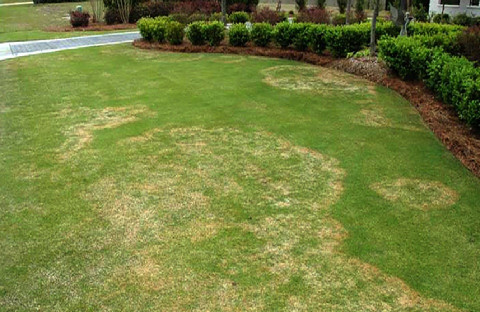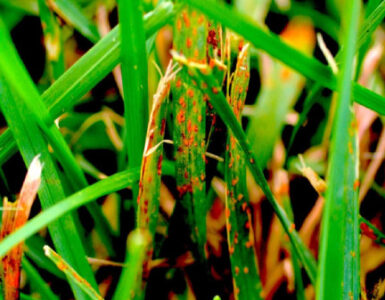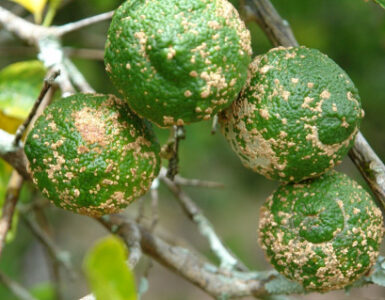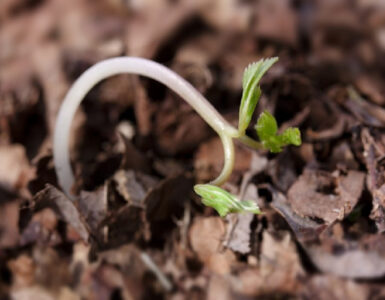Have you noticed yellow or brown patches appearing on your lawn recently? Don’t panic—it’s likely lawn fungus, and it’s a common problem for many homeowners.
The good news is that there are several natural treatments for fungus on your lawn. In this article, we’ll guide you through some simple, natural methods to eliminate lawn fungus and restore your grass to a lush, green life.
With some natural home remedies, proper lawn care, and patience, you’ll be on your way to a fungus-free yard in no time.
Identification
Look for spots or patches, especially in shady, damp areas of your yard. Fungi often appear as rings of dead or dying grass or cause grass to turn yellow, brown, or develop spots.
You may also notice a musty smell coming from the lawn.
Check if the grass pulls up easily from the soil. Take-All Root Rot, for example, can kill the roots, allowing the turfgrass to be detached with minimal effort [1].
Also, examine your grass blades closely. You’re looking for signs like powdery white residue, rust-colored spots, needle-like threads, or brown or black spots on the blades themselves.
How to Get Rid of Lawn Fungus Naturally
Once you’ve detected the symptoms, you can start treatment. These are some home remedies and natural solutions for fungus on your lawn.
1. Horticultural Cornmeal
Apply horticultural cornmeal in your yard where there are mold or fungal patches.
To use, sprinkle 1-2 pounds of cornmeal over every 100 square feet of lawn. The cornmeal is most effective when the turf is damp from rain or dew.
Also, place it around plants (both food and ornamental crops).
2. Avoid High-Nitrogen Fertilizer
Using a high-nitrogen fertilizer can increase disease problems in lawns. Nitrogen promotes lush, green leaf and stem growth that some lawn fungus pathogens feed on.
Instead, choose a balanced fertilizer. Excessive nitrogen application late in the year (November or December) also promotes snow mold growth.
3. Compost Tea
This potent solution is another excellent natural remedy for treating lawn fungus. Compost tea introduces more good microbes to your lawn, creating a balanced soil environment where disease has a hard time gaining a foothold.
To brew compost tea, fill a mesh bag with 2 cups of compost and steep it in 5 gallons of rainwater for 24 hours. You can also add a teaspoon of blackstrap molasses to the mixture.
When ready to use, combine 4 cups of this tea in a gallon of water. Next, spray the diluted compost tea solution on your lawn using a pump sprayer.
The compost tea spray will also leave behind nutrients to strengthen your grass.
4. Neem Oil
Neem oil can also help treat grass fungus and insects that may be contributing to other problems.
To use neem oil to make a homemade fungicide for grass and lawns, mix 2.5 ounces of pure neem oil with 1.5 gallons of water. Next, shake or stir the mixture thoroughly, then pour it into a spray bottle.
Finally, spray the solution onto the affected areas of your lawn. Reapply every 7 to 10 days or after rain.
5. Aerate Your Yard to Loosen Compacted Soil
This practice provides several benefits. It helps loosen compacted soil and allows for better movement of air, water, and nutrients to the grass roots.
Aerating is an easy and natural way to breathe new life into your lawn and overcome issues with fungus or pests. When combined with other practices, such as proper mowing, it will help your yard look green and gorgeous again.
6. Avoid Overwatering
Yes, this is one of the most common causes of lawn fungus and other diseases. Too much moisture creates the perfect environment for fungi and bacteria to grow.
Therefore, only water your lawn when the top few inches of soil are dry. As a general rule, most lawns only need 1 to 2 inches of water per week.
7. Mow Lawn Properly
To properly mow your lawn and prevent fungal problems, ensure you wash the mower thoroughly before use.
Mow frequently, removing no more than 1/3 of the grass blade at a time. Mowing too short can stress the grass and make it more susceptible to disease.
Also, mow when the grass is dry to avoid spreading fungal spores and bacteria. Mowing wet grass can spread disease and damage the grass.
8. Vinegar
This is another home remedy for grass fungus. The acid in vinegar helps kill fungus on contact.
You can apply vinegar directly to small patches of fungus or spray it over the entire lawn as a preventative measure.
Mix equal parts white distilled vinegar and water in a spray bottle. Spray the solution directly onto any visible fungal patches in your lawn.
The vinegar spray is a natural fungicide and helps make the grass blades slightly more acidic, which deters future fungal growth. Reapply every few weeks or after heavy rain.
9. Test Your Soil before Adjusting Its pH
Before making any changes to your lawn’s pH level, it’s crucial to test your soil to determine its current pH level.
You can purchase inexpensive soil testing kits that provide an accurate reading. A pH of 6 to 7 is ideal for most grass lawns.
If the test shows your lawn’s pH is too acidic (below 6), you’ll need to raise it by applying lime. Lime is a natural limestone product that increases alkalinity.
The ideal pH range for most lawns is slightly acidic, between 6.0 and 7.0. Adjusting the pH of the soil is vital because it impacts the availability of nutrients for your grass.
The correct pH also promotes the growth of beneficial microbes in the soil and helps prevent some common fungal diseases.
10. Soapy Water
Soapy water is a gentle, DIY treatment for grass fungus.
Mix two tablespoons of dish soap into a gallon of water. Gently stir to combine and let the bubbles dissipate.
Spray this homemade lawn fungus treatment directly onto your lawn, focusing on any visibly diseased areas. Repeated applications will kill the fungus.
11. Baking Soda
Baking soda is a natural fungicide that can help control lawn fungus organically.
To treat lawn fungus with baking soda, mix one tablespoon of baking soda with five liters of water. Spray it on the affected areas of the lawn.
The baking soda alters the pH level of the treated area, making it difficult for the fungus to continue thriving.
12. Dethatch Yard to Remove Dead Grass
One effective lawn fungus removal strategy is to dethatch your lawn. This removes the layer of dead grass clippings, roots, and debris that builds up between the grass blades and the soil.
It also allows for better air, water, and nutrient flow to the living grass plants.
13. Water the Lawn Early in the Day
Watering your lawn early in the day, preferably before 9:00 a.m., is crucial to preventing fungal growth.
Fungi love moist conditions. However, as the day progresses, the sun rises and causes the water to evaporate from the grass.
14. Monterey Complete Disease Control Biofungicide
This organic spray uses a naturally occurring beneficial bacterium to prevent and control fungal diseases in lawns and gardens. Apply it to your lawns and grassy areas as a preventative treatment.
15. Bio Advanced Fungus Control for Lawns
This biofungicide works against lawn diseases, including red thread disease, dollar spot, lawn rust, and brown patch.
Use BioAdvanced according to the package instructions to help treat lawns affected by fungus.
Takeaway
So there you have it: some easy and natural remedies to control lawn fungus and have your yard back to vibrant green in no time. There is no need for harsh chemicals or expensive treatments.
Your lawn and your family will thank you, and you’ll feel good knowing you accomplished it in an eco-friendly way.








Add comment